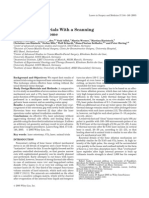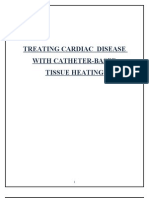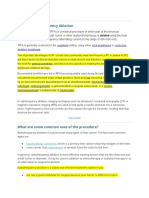Resumo 150122438 RF Currents
Resumo 150122438 RF Currents
Uploaded by
Daniel Moreira CarreiraCopyright:
Available Formats
Resumo 150122438 RF Currents
Resumo 150122438 RF Currents
Uploaded by
Daniel Moreira CarreiraOriginal Title
Copyright
Available Formats
Share this document
Did you find this document useful?
Is this content inappropriate?
Copyright:
Available Formats
Resumo 150122438 RF Currents
Resumo 150122438 RF Currents
Uploaded by
Daniel Moreira CarreiraCopyright:
Available Formats
Resumo anatomia e fisiologia
Texto base: Radiofrequency based hyperthermia therapy: A centennial
technique serving modern surgery
Aluno: Daniel Moreira Carreira
Matrícula: 15/0122438
Resumo
The article discusses the idea that Radiofrequency currents can be used
to heat biological tissue in therapy and surgery and different examples of current
clinical applications of RF currents.
The use of heat therapy was employed in old medicine for thousands of
years to purify and to detox tissue among other things. The procedure of
cauterization for bleeding arrest was known by Hippocrates on dates before
Christ, the millennial Indian culture used heated bars to stop bleeding, but one
big problem always existed, the great amount of pain that introduced extreme
heat in contact with tissue.
In 1891 a breakthrough in tissue heating technologies occurred,
d’Arsonval figured out that high-frequency currents did not produce any kind of
nervous or muscular reaction, therefore no pain, and yet gradual heating could
be controlled. The use of metallic elements was used to close the electric circuits
through contact with the skin, these elements were electrodes. The main
discovery of it all was to find out that biological tissue could be heated with an
electric current and not only by thermal conduction. Later on, this technology
would be progressed to our current electrosurgery. Frequencies between 300kHz
and 1 MHz are called radiofrequency currents.
In order to understand how the interaction of RF currents and biological
tissue works, first, we must understand how some cells can be stimulated. If on
one hand, we have the case of electrons carrying the electric charge in metals,
on the other hand, ions are responsible for that in the biological tissue, so if we
put two metallic electrodes in contact with the tissue and apply a voltage potential,
ions would be carried towards the electrode of opposite sign. If this variation
surpass the threshold value, a series of phenomena are produced, stimulating
the cell. That is the principle behind electrosurgery and in the case of muscle
cells, it implies a mechanical contraction.
In the case of RF currents, an alternate current power supply is used in
the frequencies mentioned before. Since the alternate current is operative, the
ions on the tissue go back and forth in a very high velocity, similar to the behavior
of electrons on metals, and because of that this period is sufficiently short enough
to avoid tension across the tissue, but still produces heat through the fast motion.
That is why RF currents can produce heat without any pain.
The heating procedure occurs in a very rapid way and the tissue can be
heated up to 60°C in a few seconds depending on the applied electric power.
One of the main reasons this is targeted is because once the tissue reaches
50°C, the coagulation of the proteins of the cells happens, implying instantaneous
cellular death by coagulative necrosis. This type of coagulation is called white
coagulation.
Radiofrequency can be applied to many different uses and objectives. The
article talks about a number of those examples and to sum up, they will be divided
into topics:
RF cardiac ablation: the main objective is the elimination of cardiac
arrhythmia, which is an electrical malfunction of a certain group of cardiac
cells. When introduced the electrical current in the tissue just under the
ablative electrode, causes a rise in temperature and therefore the
destruction of the malfunctioning cells. This procedure is used nowadays
to treat some arrhythmias that otherwise would have to undergo a more
complex and risky surgery.
RF ablation of tumors: the other application of the RF currents are the
destruction of malign tumors. The procedure consists of an electrode
placed inside the tumor and once it reaches the center, a current is applied
until the temperature of the cells exceeds the critical temperature, around
50°C, for several minutes. How the electrode reaches, the tumor depends
on the approach of the doctors, it can be through a little incision guided by
some sort of image technique, such as ultrasound, for instance, or in a
very different approach, if the patient has already been opened, it can
easily be placed on the organ exposed.
RF-assisted resection: consists of a device capable of producing RF
currents to reduce as much as possible the bleeding associated with the
excision of the part of an organ that contains a tumor by activating the
coagulation cell through the heating procedure mentioned before.
Cosmetic surgery applications: the use of RF currents are being used in
the field of cosmetic surgeries as a non-invasive technique for selecting
the heating of adipose tissue by destroying the adipocytes, or cells that
contain fat. The fat tissue heats much faster than the muscle, which is a
good thing in cosmetic surgery but not desirable in procedures such as
breast cancer. When the electric field is not normal to the tissue surfaces,
the skin heats faster than the fat, being a great use to stimulate collagen
fibers that lead to firmer skin, similar to what a younger appearance should
look like
RF thermokeratoplasty: other thermal applications of RF currents by
contracting irreversibly the collagen fibers. One example of this use is in
cornea surgery using very small electrodes. The goal is to produce an
irreversible contraction of the corneal stroma collagen, therefore producing
a permanent change in the curvature. This procedure has been used to
treat astigmatism, keratoconus, and hyperopia.
Sphincter reshaping by RF: this is also caused by the contraction of the
collagen fibers, in this case, to correct the sphincters. It can be used to
treat the cardiac sphincter, which connects the esophagus to the stomach,
when dealing with gastric reflux, or to treat fecal incontinence.
Radiofrequency somnoplasty: another application of collagen contraction
is the treatment of obstructive sleep apnea, by stimulating contraction of
the tissue whose function is the obstruction, like the soft palate, to stretch
the tissue that was excessively relaxed.
Bronchial thermoplasty: is based on ablations of the smooth muscles of
the airways, such as asthma, by targeting the capacity of structures to
constrain the frequency of asthmatic episodes can reduce considerably.
RF-based bipolar sealing systems: this procedure uses the classical
technique of bipolar electrodes blood vessel coagulation. This technology
has experienced considerable progress resulting in homeostasis systems
adapted to specific procedures, aimed at treating hemorrhoids, the thyroid
gland, or the pancreatic tissue.
Transurethral resection of the prostate: in this procedure electrodes have
been modified into more complex devices, also used to produce incisions
of the prostate, neck, bladder, or the resection of bladder tumors.
Transurethral needle ablation (TUNA) is the name of a new technique in
which is targeted in the ablation of the prostate in patients with benign
prostate hyperplasia.
As discussed, RF currents have many applications, nonetheless, new
technologies are being searched by focusing on three main approaches:
1. To design applicators that increase the efficacy and safety of the
conventional techniques, allowing to have surgeries as minimally invasive
as possible;
2. To achieve higher spatial accuracy by developing imaging techniques
enabling to make of thermal lesions in the right place;
3. To have systems capable of real-time information on the lesion, both its
geometry, and characteristics.
The goal among the scientists and academy is to perform surgeries with
electrodes that enable them to introduce through very small orifices and still be
very accurate. The use of nanoparticles is also being developed to have a more
circumscribed thermal effect in the case of the ablation of tumors.
In addition, we should not forget that any advance in this technology affects
directly all sorts of surgeries and treatments currently in use meaning greater
safety and efficiency in the diverse world that is medical assistance.
You might also like
- Wheres Waldo Now Deluxe Edition PDF Ebook by Martin HandfordDocument3 pagesWheres Waldo Now Deluxe Edition PDF Ebook by Martin HandfordNovianto Yang0% (4)
- Esu Testing (Iec 60601-2-2)Document41 pagesEsu Testing (Iec 60601-2-2)Marcele FonsecaNo ratings yet
- Tecar TerapiaDocument5 pagesTecar TerapiacukromatNo ratings yet
- Principles of Electrosurgery - MegadyneDocument21 pagesPrinciples of Electrosurgery - Megadynemihaesdenis8575100% (2)
- The Skin Effect and Bio-Electrical Impedance AnalysisDocument0 pagesThe Skin Effect and Bio-Electrical Impedance Analysisnikos2119855070No ratings yet
- Bio Electromagnetic Implications For Health and Healing - Valone 2010Document6 pagesBio Electromagnetic Implications For Health and Healing - Valone 2010Thomas Valone100% (2)
- Everett Watkins Power of PlayDocument24 pagesEverett Watkins Power of PlayToon HeesakkersNo ratings yet
- ElectrosurgeryDocument22 pagesElectrosurgeryRavish BangreNo ratings yet
- Radiofrequency AblationDocument6 pagesRadiofrequency Ablationraviks34No ratings yet
- Coblation in ENT PDFDocument45 pagesCoblation in ENT PDFLoredana Albert CujbaNo ratings yet
- Walt-low-Energy Laser Therapy As Quantum MedicineDocument4 pagesWalt-low-Energy Laser Therapy As Quantum Medicinemuitasorte9No ratings yet
- Electrosurgical UnitDocument14 pagesElectrosurgical UnitLil ManNo ratings yet
- 4 Us PDFDocument7 pages4 Us PDFJenny VibsNo ratings yet
- Phy Agent 8817Document9 pagesPhy Agent 8817shahabahmadNo ratings yet
- Chapter-4 Physiotherapy and Radiotherapy Equipment: 4.1 High Frequency Heat TherapyDocument8 pagesChapter-4 Physiotherapy and Radiotherapy Equipment: 4.1 High Frequency Heat TherapyAnup SapkotaNo ratings yet
- FTP IvanenkioDocument5 pagesFTP Ivanenkiorwong1231No ratings yet
- HemoestasisDocument17 pagesHemoestasisashakanasadi98No ratings yet
- Common Uses and Cited Complications of eDocument42 pagesCommon Uses and Cited Complications of eJosé Alberto BurláNo ratings yet
- Eng Tecar-Crv-200 Rev1 LRDocument36 pagesEng Tecar-Crv-200 Rev1 LRThe LamNo ratings yet
- Diathermy Got 121Document9 pagesDiathermy Got 121jimgitongaNo ratings yet
- Therapeutic Perspectives of High Pulse Repetition Rate ElectroporationDocument16 pagesTherapeutic Perspectives of High Pulse Repetition Rate ElectroporationOisin McGleenanNo ratings yet
- High Efficiency Cardiac System For Cardiac TherapyDocument32 pagesHigh Efficiency Cardiac System For Cardiac TherapyKshitij PawarNo ratings yet
- Heat and Cold in MedicineDocument33 pagesHeat and Cold in Medicineاحمد احمدNo ratings yet
- Jimenez Lozano 2013Document13 pagesJimenez Lozano 2013Ingook SongNo ratings yet
- Esu BASICS 5Document9 pagesEsu BASICS 5Bmet ConnectNo ratings yet
- Lec-01 Introduction PA - Electro-IDocument47 pagesLec-01 Introduction PA - Electro-IAHMAD AliNo ratings yet
- Springer Healthcare Harmonic Ace 7 Shears Manuscript PDFDocument26 pagesSpringer Healthcare Harmonic Ace 7 Shears Manuscript PDFRythm JamesNo ratings yet
- Collective Task 2 - Effects of The Electric Current. Property of The Eye.Document2 pagesCollective Task 2 - Effects of The Electric Current. Property of The Eye.ibrahimjahangir1No ratings yet
- Introduction To Physical Agents & Electrotherapy - DPT-V: DR - Fouziabatool PT - PP-DPT Lecturer, RCRSDocument48 pagesIntroduction To Physical Agents & Electrotherapy - DPT-V: DR - Fouziabatool PT - PP-DPT Lecturer, RCRSMuhammad Fakhar AbbasNo ratings yet
- Unit 4 notes-MEDocument17 pagesUnit 4 notes-MEKowsi MathiNo ratings yet
- Tiktinsky Et Al - Electrotherapy, Yesterday, Today and TomorrowDocument6 pagesTiktinsky Et Al - Electrotherapy, Yesterday, Today and TomorrowCRISTOBAL JAVIER LOPEZ ALISTENo ratings yet
- Histologico Radio GorduraDocument6 pagesHistologico Radio GorduraBianca SouzaNo ratings yet
- Review Article: Use of Radiofrequency Ablation in Benign Thyroid Nodules: A Literature Review and UpdatesDocument8 pagesReview Article: Use of Radiofrequency Ablation in Benign Thyroid Nodules: A Literature Review and Updatesagita kartika sariNo ratings yet
- Electrosurgery and Energized Dissection: Basic SkillsDocument5 pagesElectrosurgery and Energized Dissection: Basic SkillsMadalina PişteaNo ratings yet
- Diathermy: Diathermy Is A Greek Word Meaning Through HeatingDocument8 pagesDiathermy: Diathermy Is A Greek Word Meaning Through HeatingZA IDNo ratings yet
- 2024-2 ENERGIA - CompressedDocument54 pages2024-2 ENERGIA - CompressedSandoval SobrinhoNo ratings yet
- EM Waves Applications in Medical Field: DR Kadry Awad Toqa Ahmed 20170278Document6 pagesEM Waves Applications in Medical Field: DR Kadry Awad Toqa Ahmed 20170278Osama abdurahmanNo ratings yet
- Jurnal VarisesDocument4 pagesJurnal VarisesMas AbrarNo ratings yet
- Os LitDocument5 pagesOs LitCedinne Gem UroaNo ratings yet
- Ultrasound TherapyDocument43 pagesUltrasound TherapyGeddam Snehalatha100% (2)
- By . DR Shivraj Sharma 1 Year Resident Dept - of General Surgery NMCTH, BirgunjDocument32 pagesBy . DR Shivraj Sharma 1 Year Resident Dept - of General Surgery NMCTH, BirgunjVu ThangNo ratings yet
- Science of Radio Frequency DevicesDocument26 pagesScience of Radio Frequency DevicesJolene Ritter100% (1)
- ArsurileDocument6 pagesArsurileNicolae Alexandru GheorghiuNo ratings yet
- Collective Task 3 - Advanced Imaging Methods.Document3 pagesCollective Task 3 - Advanced Imaging Methods.ibrahimjahangir1No ratings yet
- Project in MAPEHDocument14 pagesProject in MAPEHRamel Yen CerantesNo ratings yet
- The Basics of DiathermyDocument7 pagesThe Basics of DiathermySun HtetNo ratings yet
- Radiofrequency in Cosmetic DermatologyDocument12 pagesRadiofrequency in Cosmetic DermatologyThe Vancouver Sun100% (2)
- Safe Energy Use in The Operating RoomDocument22 pagesSafe Energy Use in The Operating RoomBolivar IseaNo ratings yet
- Treating Cardiac Diseas 2Document20 pagesTreating Cardiac Diseas 2Muhammed Luthufi E100% (1)
- Camex Wellness LTD: 1.what Is Electrotherapy?Document4 pagesCamex Wellness LTD: 1.what Is Electrotherapy?ritesh_mistry23No ratings yet
- Uses of Physics in Medical TechnologyDocument6 pagesUses of Physics in Medical Technologyaqeeaba nasirNo ratings yet
- Attr 37 03 0293Document7 pagesAttr 37 03 0293api-248999232No ratings yet
- Ch. 38 Biomedical Phy.Document17 pagesCh. 38 Biomedical Phy.Mahmoud Abu MayalehNo ratings yet
- The Application of Thermal Image Analysis To Diabetic Foot DiagnosisDocument7 pagesThe Application of Thermal Image Analysis To Diabetic Foot DiagnosisDilip KenNo ratings yet
- محمد هشام الجندىDocument8 pagesمحمد هشام الجندىmohamed el khoulyNo ratings yet
- 2020 Article 1026Document29 pages2020 Article 1026Sheyda MavisatNo ratings yet
- Proyecto EstanciaDocument15 pagesProyecto Estanciaarath jaimesNo ratings yet
- Radiofrequency AblationDocument7 pagesRadiofrequency AblationRohit singhNo ratings yet
- Electrotherapy: Current"Document3 pagesElectrotherapy: Current"Mohamed ElMeligieNo ratings yet
- Lasers in Urology DR BiokuDocument33 pagesLasers in Urology DR BiokumbiokuNo ratings yet
- Worksheet 2Document9 pagesWorksheet 2Yan Hao NamNo ratings yet
- Points %: Clinical Practice Evaluation 3Document12 pagesPoints %: Clinical Practice Evaluation 3api-501699429No ratings yet
- Section 3: Preparing A Trial Balance: - Enduring UnderstandingsDocument26 pagesSection 3: Preparing A Trial Balance: - Enduring UnderstandingsBo Na YoonNo ratings yet
- English: 1. Concrete Noun - Noun That CanDocument4 pagesEnglish: 1. Concrete Noun - Noun That CanIrish VillanuevaNo ratings yet
- Empowerment Technology - Q4M3Document13 pagesEmpowerment Technology - Q4M3ANTONETTE P. CASTILLO100% (1)
- CV-2023-009785 Schwartz V Delaware County Et Al Judge Capuzzi Opinion 07FEB2024Document9 pagesCV-2023-009785 Schwartz V Delaware County Et Al Judge Capuzzi Opinion 07FEB2024Kyle BeckerNo ratings yet
- CIMA P2. Cap 3. Costing TechniquesDocument31 pagesCIMA P2. Cap 3. Costing TechniquesjuanNo ratings yet
- NCP Impaired Skin IntegrityDocument3 pagesNCP Impaired Skin IntegrityMiar QuestNo ratings yet
- Specific TL ActivitiesDocument2 pagesSpecific TL ActivitiesTeresa Pajarón LacaveNo ratings yet
- Dev Psych - Midterm Examination - ReviewerDocument16 pagesDev Psych - Midterm Examination - ReviewerAudije, John Michael M.No ratings yet
- Chapter - 3 "Risk Assessment and Internal Control": Lecture - 19Document8 pagesChapter - 3 "Risk Assessment and Internal Control": Lecture - 19Aruna RajappaNo ratings yet
- Key Lesson 14Document5 pagesKey Lesson 14Phan Minh Hiền NguyễnNo ratings yet
- Annotated Lesson PlanDocument12 pagesAnnotated Lesson Planapi-344782282100% (4)
- English ASLDocument11 pagesEnglish ASLIshaNo ratings yet
- CINQUAINDocument14 pagesCINQUAINJeacelle MendiolaNo ratings yet
- International Journal of Industrial ErgonomicsDocument11 pagesInternational Journal of Industrial ErgonomicsyukyNo ratings yet
- Subject Verb AgreementDocument2 pagesSubject Verb AgreementEdmun Sionomio GregoriNo ratings yet
- TPM QM TrainingDocument16 pagesTPM QM TrainingSunil100% (3)
- CPA Board Examinations QuestionsDocument14 pagesCPA Board Examinations QuestionsJeane BongalanNo ratings yet
- ZOOMER Magazine Media Kit 5.7.2010 PDFDocument19 pagesZOOMER Magazine Media Kit 5.7.2010 PDFZoe NguyenNo ratings yet
- Ib-Where We Are in Place and TimeDocument4 pagesIb-Where We Are in Place and TimeSaba Khan100% (1)
- OB Reading NotesDocument10 pagesOB Reading NotescompangelNo ratings yet
- Buckling Loads For Variable Cross-Section Members With Variable Axial ForcesDocument9 pagesBuckling Loads For Variable Cross-Section Members With Variable Axial Forcessilillo100% (1)
- S SSP 2013 RossiterDocument9 pagesS SSP 2013 RossiterJoan MilenovNo ratings yet
- KKKDocument60 pagesKKKblah blah 56743No ratings yet
- Unit 1Document11 pagesUnit 1manikantathummalapudiNo ratings yet
- Financial Risk Management Thesis TopicsDocument4 pagesFinancial Risk Management Thesis Topicsdwsmpe2q100% (2)
- CL 6 Engleza CorigentaDocument3 pagesCL 6 Engleza CorigentaMIHAELA RAMONA BURCUNo ratings yet

























































































